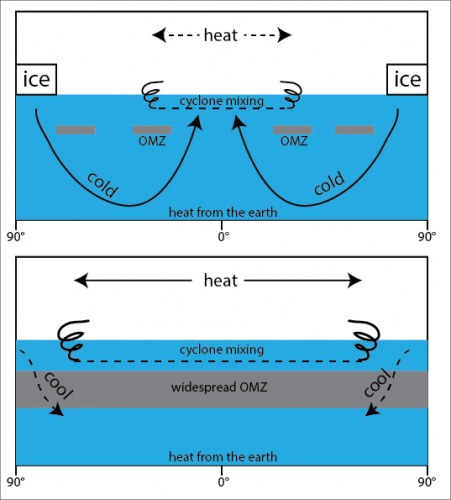Recent work (summarized here) suggests that climate change is already weakening our ocean’s circulation network. The evidence outlined in these studies is important for us to understand since the ocean’s circulation can directly affect the Earth’s atmosphere and biosphere. Weakening ocean currents can increase ocean acidification and make it difficult for marine life to survive.
What is ocean circulation?
Ocean circulation occurs both in the surface waters and in the deep ocean on Earth and is very interconnected to other spheres, such as the atmosphere and the biosphere.
Movement on the ocean’s surface is largely controlled by two phenomena: differential heating and the Coriolis Effect. Differential heating refers to changes in water temperature from the poles to the equator. The Coriolis Effect moves objects or currents on Earth’s surface in one direction in the Northern Hemisphere and another direction in the Southern Hemisphere. These surface currents move bodies of air and water to different regions of Earth, transporting moisture and nutrients along the way.
Deeper water, on the other hand, circulates through a process called thermohaline circulation. This process is driven by differences in water density driven by temperature (thermo) and salinity, or salt content (haline). Cold water is denser than warm water and salty water is denser than freshwater. This type of circulation affects the entire Earth.

So, what happens as climate change continues to warm Earth’s oceans?
Warming temperatures result in weakened currents. If the water at the poles is not as cold and dense, it simply won’t be able to circulate as well. Additionally, the melting of the Greenland continental ice sheet is pouring freshwater into the salty ocean, again altering the density of the water masses.
The difference in water density promotes stratification, or more defined layering of the ocean. The increased stratification causes boundaries between water masses, reducing transfer of dissolved compounds such as oxygen and carbon dioxide. If oxygen is unable to reach the deep ocean, this results in oxygen minimum or depleted zones where much of life is no longer able to thrive.
Likewise, in modern-day oceans, the thermohaline circulation mixes dissolved gases (such as carbon dioxide and oxygen) into the deep ocean. This means that the oceans are able to draw down and store more carbon dioxide from the atmosphere. The deep ocean is the largest reservoir (or storage) for carbon dioxide on Earth.
If circulation slows due to warming waters, the churning of the carbon dioxide will slow, which will keep more carbon dioxide in our surface waters and atmosphere. This can lead to increasing ocean acidification, which is very harmful to marine life.
Further reading and viewing:
- NOAA What is a current?
- NOAA Ocean Currents
- World Ocean Review: The oceans – the largest CO2-reservoir
- NASA The Thermohaline Circulation – The Great Ocean Conveyor Belt
- Smithsonian Ocean Currents: Motion in the Ocean
- Ocean Circulation & Stratification
- Ocean Stratification demonstration
- Scientists Say Ocean Circulation Is Slowing. Here’s Why You Should Care